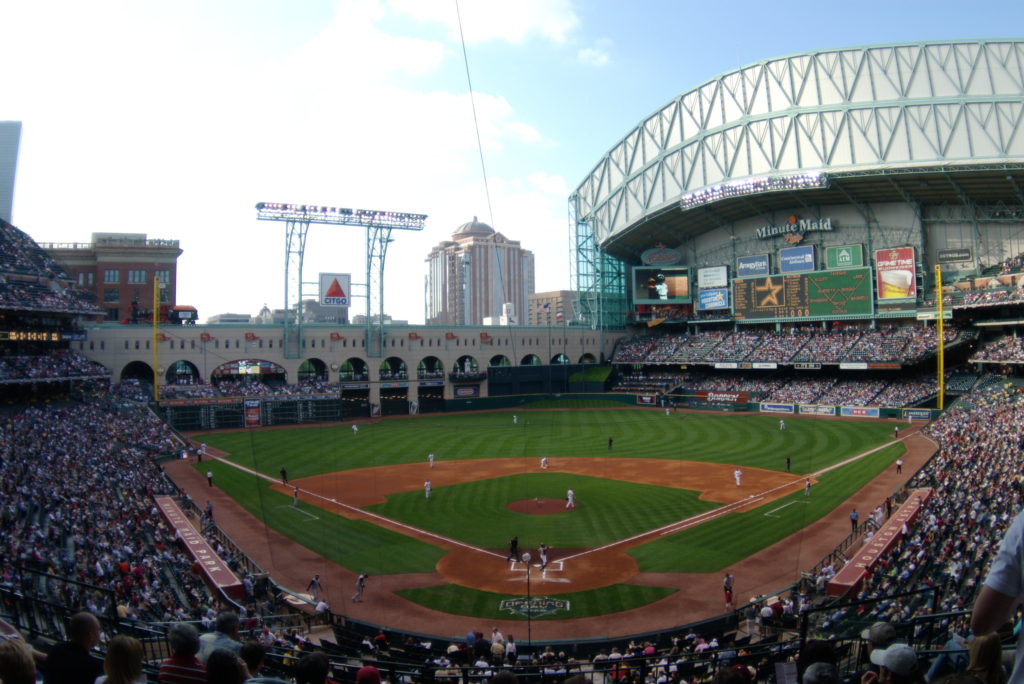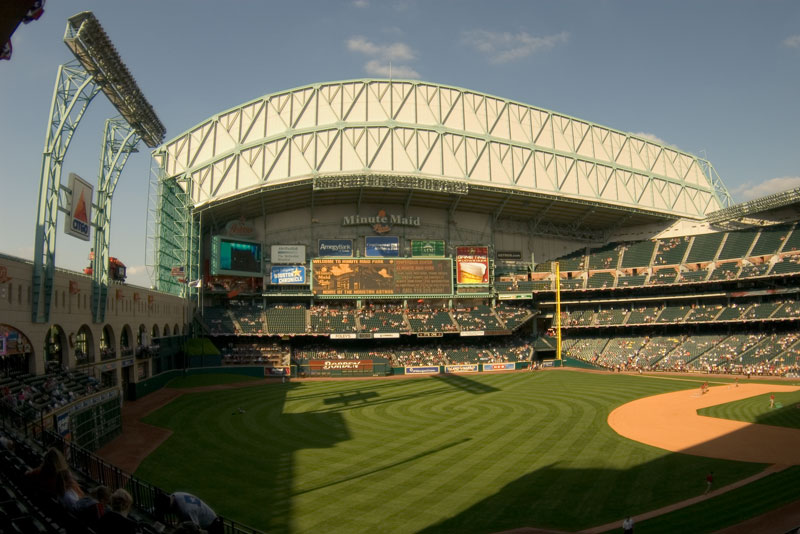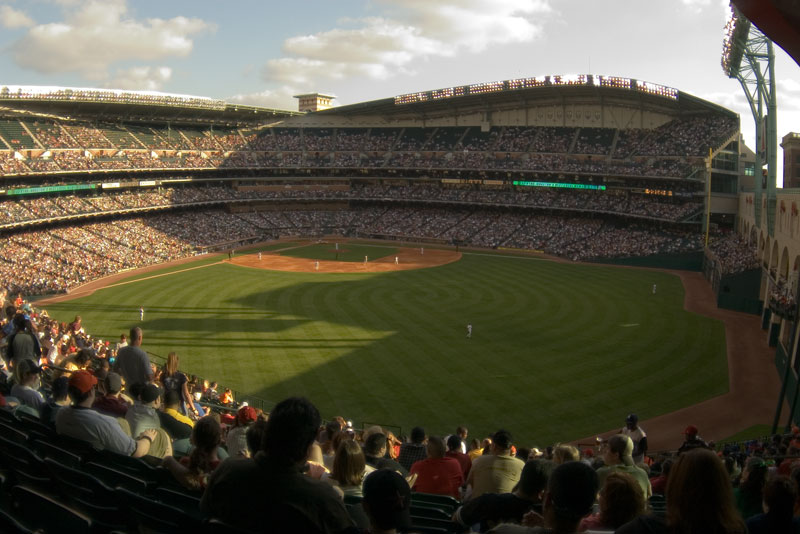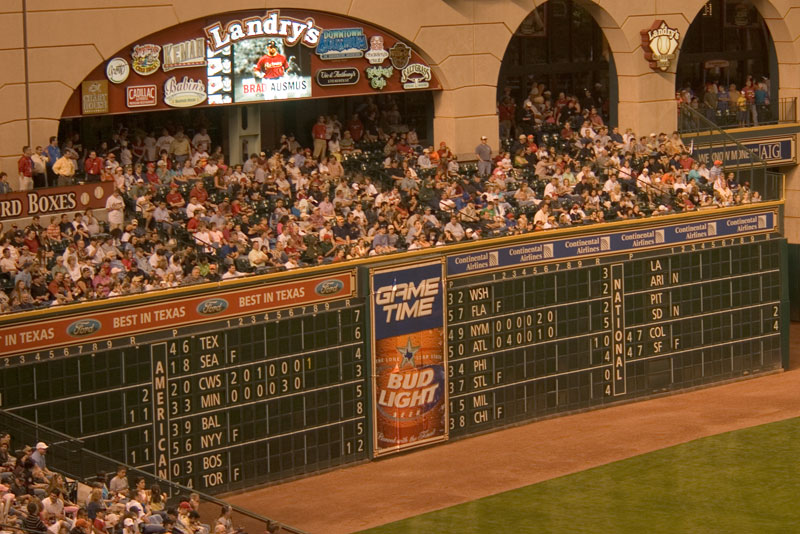The folks in Houston aren’t afraid to think big. The original home of the Houston Astros, the Astrodome, was hailed a modern wonder of the world. Curiously, Minute Maid Park doesn’t seem to be quite as impressive an undertaking as the Astrodome, at least when you approach it from downtown Houston. True, the plan is immense, especially when the roof is closed. But when compared to the other mega-ballparks built in the last 10 years, the place is definitely on a human scale from the outside.
Year Opened: 2000
Capacity: 40,950
Architect: Populous
Dimensions: 315L, 362LC, 435C, 436RC, 373RC, 326R
Playing Surface: Grass
Website: houston.astros.mlb.com
Phone: 713/259-8000
Ticket Prices: Dugout Boxes, $50; Field Boxes, $39; Crawford Boxes, $34; Bullpen Boxes, $26; Tier I Club Seats, $52; Tier II Club Seats, $44; Mezzanine, $20; Terrace Deck, $22, View Deck I, $15; View Deck II, $12; Outfield Deck, $7; Outfield Deck (Children), $1
View Seating Map Here!
League: National League
Parking: Minute Maid Park is on the northeastern edge of downtown Houston, adjacent to the city’s convention center and Toyota Center, the home of the NBA’s Houston Rockets. As such, there’s an abundance of parking lots in the surrounding area — 25,000 spots are available most nights. In addition, there’s free street parking to the south of the ballpark if you arrive early enough.
Directions: U.S. Highway 59 and Freeways I-45 and I-100 converge in downtown Houston. You can use any of them to get close to the ballpark; all three feature signs directing the way to the ballpark.
Written by: Kevin Reichard
Perhaps that’s because there’s really no theme to the exterior: form follows function in that the exterior really serves as a support for the huge retractable roof. There’s a reason why we are not running a photo of the exterior: it defied all efforts to provide a signature exterior shot.
And, curiously enough, from the inside as well. The signature architectural element of Minute Maid Park is the 242-foot-high retractable roof. Houstonians like to block out the elements (though with the elements as they are in Houston it’s understandable), and the roof keeps it cool in summer. Early in the season — when we visited — the roof is left open, as the lovely spring weather makes for a perfect outdoor ballpark experience. The roof does dominate the proceedings at Minute Maid Park: after a while you get used to its rather massive presence (and these photos tend to minimize its impact, as opposed to when you’re there in person), but everything is larger than life in Texas, and Minute Maid Park is no exception.
One negative to our visit: because the weather was so gorgeous, the roof was open when we arrived at the ballpark. so we couldn’t judge how the ballpark felt with it closed. However, we did talk to some season-ticket holders who said the ballpark feels fairly open even with the roof closed: because the wall in back of the railroad track is glass, you can still see the downtown Houston skyline and feel the sunlight pouring in.
Aside from the roof, the ballpark is curiously understated when it comes to bells and whistles, though the curvilinear look to the grandstand is a little more reminiscent of European sports facilities than ballparks. In fact, one of the coolest things about the ballpark is the interplay between the sensually curved elements (like the roofline down the third-base line and the retracted roof) and the rigid straight lines of the diamond, the foul poles and the adjoining train station. In that sense there’s a somewhat European feel to Minute Maid Park — and Houston would be one of the last places you’d expect it.
In most other ways Minute Maid Park follows the physical and financial model of new downtown MLB ballparks built in the last 10 years. The location is pretty decent: it’s easily accessible from the entire Houston area thanks to the freeways flowing close to the ballpark, and there’s plenty of parking thanks to a next-door convention center and Toyota Center down the way. There is a variety of seat price points, ranging from the pricey lower-level seats and the obligatory club-levels seats to midrange bleacher seats and very cheap seats ($1!) in right field. With a concourse ringing the ballpark, there are plenty of places to stand around and watch the action. And the concessions are plentiful, through there are some Texas touches (which we’ll discuss later).
Besides the roof, there are a few signature touches to the ballpark. One of the main entrances to the ballpark — and the one used by most fans — is Union Station, the city’s former train station. Opened in 1911, Union Station was the main entry to Houston for three generations of Texas Now, as far as former train stations go, Union Station is on the smaller side, but it suits the scale of the ballpark perfectly. You walk through the former station and encounter left field as seen through a series of arches designed to evoke a rail bridge. (The station is also functional: it contains the Astros team offices and the roof features a group party space.) This part of the concourse actually extends over the field of play, giving you a pretty unique view of a left fielder when he scrambles to chase a ball rolling to the fence. In the photo above you can see Union Station in the background; you can also see the rail bridge along the outfield. To the right is the view from the concourse under the arches; it’s a popular place to gather and watch the game. Above is the obligatory nod to the balcony’s sponsor; the gas pump also tracks how many homers have been hit at Minute Maid Park.
The railroad theme is extended from the Union Station entrances; concession booths are built like cabooses, and a locomotive runs along the track above the left-field concourse. (This is a real train, by the way, weighing over 500,000 pounds.) When the Astros hit a homer, the engineer climbs aboard and the train chugs a little way down the track. Now, we’ve expressed some displeasure before with overly themey ballparks (see our look at Great American Ball Park for an example), but here the themed elements were appropriate and not overdone.
Left field is also home to some of the coolest bleachers in the majors, the Crawford bleachers. At $27, the Crawford Box seats are fairly spendy for left-field bleachers, but at only 315 feet from home plate, they’re a pretty intimate set of bleachers.
There are a few drawbacks — fans sitting there can’t see the train or the old-fashioned hand-operated scoreboard beneath them — but most fans seemed happy to be there nevertheless.
The bleachers in right field are a complete different beast. On the bottom level are bullpen box seats, which are farther away from the infield than the left-field bleachers but offer an intimate view of the bullpen.
On the second level of right field are the cheap, cheap seats: $7 for adults and $1 for kids. For the money, these are pretty decent seats: the view is distant and you can’t see the mondo scoreboards at your back, but you get plenty of concessions and a price suitable for a family.
In the middle: “Tal’s Hill,” a slope in the deepest part of center field. Named for Astros President Tal Smith, the slope rises 20 degrees and contains a flagpole in play. It presents a definite home-field advantage: more than one visiting center fielder has paused before following a fly ball up the slope. Interestingly, there was a similar hill in Crosley Field‘s center field, but it was not recreated in Great American Ball Park — though Albuquerque’s Isotopes Park contains a center-field hill as well.
All the seats we viewed are generally skewed toward the playing field, though some may be slanted more toward the outfield than the pitching mound. However, the grandstand down each line was curved in toward the infield, making them decent places to watch the game.
One thing about Minute Maid Park: this is a ballpark where the suites do not dominate the action. In a state and a city where excess is all, it’s somewhat surprising to see such a subtle approach to the most expensive seats in the house.
Concessions
Texas is beef country, and the best food at Minute Maid Park comes off the hoof — or at least processed from something coming from a hoof.
Having said that, one thing is certain: the food is expensive and ordinary. The hot dogs come in a number of sizes — $5.25 for a foot long, $4 for a Super Star Dog. Also abundant was concession stands offering Mexican food and BBQ (the brisket was pretty decent). There’s also a stress on national brands as opposed to local delicacies: the pizza comes from DiGiorno and the ice cream comes from Dreyers.
The selection of beverages for grownups is mixed. Most concession stands feature the old warhorses — Miller Lite, Bud Light, Bud, Coors Light — while a few feature Shiner Bock in bottles and on tap. If you care at all about beer, take the extra time to seek out a Shiner Bock (we saw only one Shiner Bock tap on the main concourse); it’s what the enlightened locals drink, even though it costs a whopping $8.75 for a 24-ounce cup. You can find real liquor on the Club level and in the ballpark restaurants, but the margaritas sold in the main concourses do not have real tequila.
If sit-down fare is your preference, there are a few places to dine at the ballpark. The Mexican restaurant located down the right-field line, 9 Amigos, is huge, and there was a fairly long line of folks waiting to get in before the first pitch during our visit. (In addition, Larry’s Big Bamboo is located behind home plate and serves Caribbean-tinged bar food (chicken tenders, burgers, etc.). It’s named for Astros broadcaster (and former manager and pitcher) Larry Dierker. As a plus, it’s one of the few places in the ballpark where smoking is allowed, Shiner Bock is on tap, and it features a full bar.
Team Ballpark History
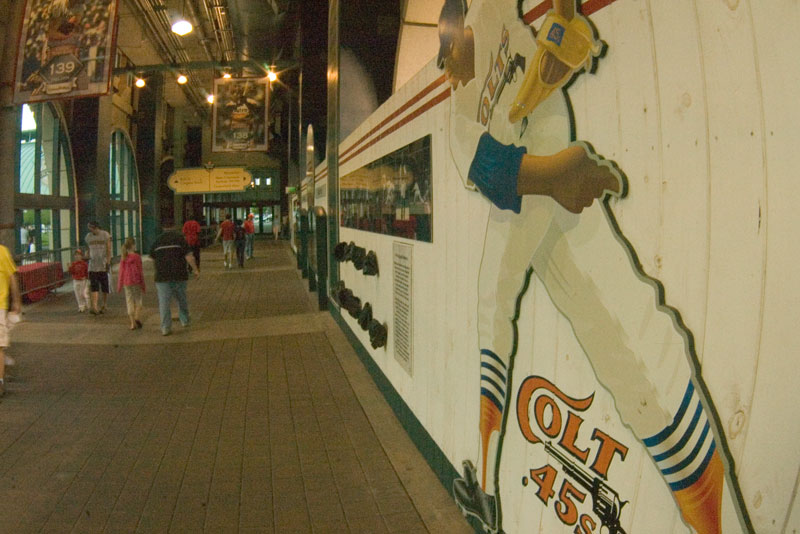
The Houston Astros began life as the Houston Colt .45s, entering the National League in 1962 and playing for three years at Colt Stadium, a temporary structure next to the future site of the Astrodome. Check out this page for more information on the Colts and Colt Stadium. The Astros play homage to the Colt .45s era in the left-field concourse with an exhibit on team history.
In 1965 the team underwent a name change and moved into the Houston Astrodome, the first domed stadium dubbed the Eight Wonder of the World by Houston sports aficionados. The initial design of the Astrodome featured translucent panels on the roof in order to let in enough light to grow grass, but the experiment in stadium grass failed — the Astros were forced to adopt Astroturf to make a playable field under the dome. The Astrodome still stands next to Reliant Stadium, the home of the NFL’s Houston Texans.

